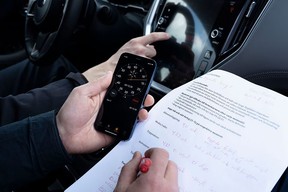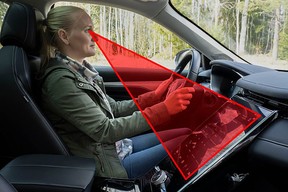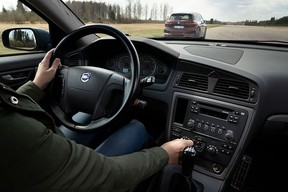A study by a Swedish magazine proves it takes twice as long to futz with software than fiddle with a physical button

Article content
Distraction: it’s the new alcohol. Every day, nine Americans die as a result of distracted driving. More than 3,000 every year. After alcohol impairment, which kills one person every 45 minutes on American roads, schmucking into things while your eyes aren’t on the road is the second-most-frequent cause of fatalities on our roads.
Advertisement 2
Article content
And, of course, it’s not just people in cars who are the victims. According to the U.S. Centre for Disease Control and Prevention (CDC), more than 600 of those victims were not inside a vehicle of any kind, meaning more than 20 per cent of the accidents caused by distracted drivers kill pedestrians, bicyclists, and joggers. That is, once again using perhaps the most incredulous metric detailing this scourge, two passers-by perishing every day because some imbecile can’t keep their eyes on the road.
Cell phones have borne the brunt of the blame in this death by distraction. That’s understandable since, whether you’re texting or talking, operating a cell phone covers the trifecta of the CDC’s classifications of distraction, namely: visual, taking your eyes off the road; manual, taking your hands off the wheel; and cognitive, taking your mind off driving.
Advertisement 3
Article content
-
![Motor Mouth: Have we finally reached Maximum Musk Meltdown?]()
Motor Mouth: Have we finally reached Maximum Musk Meltdown?
-
![Motor Mouth: Fearless automotive predictions for 2023 and beyond]()
Motor Mouth: Fearless automotive predictions for 2023 and beyond
There are, of course, other distractions within the cabin. Conversing in a car is, naturally, a cognitive distraction. Checking if you attached the baby seat correctly means you have to take your eyes off the road. And presumably, you’d have to take at least one hand off the wheel to eat something while driving. The difference is that most other distractions don’t combine all three forms of diversion, nor do they, generally, last very long. More importantly, cell phones are the new preoccupation on the block, screaming kids in the back seat and eating a burger while cruising the super-slab being as old as the car itself. In other words, distraction’s increase in accidents and fatalities, in most minds, is caused by the cell phone and the cell phone alone.
Advertisement 4
Article content
Not so fast, says a Swedish car magazine. According to Vi Bilägare, the modern touchscreen is a huge step backward in terms of safety and distracted driving compared with the buttons and switches of yore. In fact, in its testing, a lowly 2005 Volvo V70 — completely devoid of anything remotely tablet-like — offered drivers much less distraction than the touchscreen tablets and voice-activated controls in modern cars. But, in their desire for “clean” interiors with minimal switchgear, says author Fredrik Diits Vikström, car manufacturers have ditched physical buttons and switches, though they be “far superior safety-wise.”

To prove it, Vikström and his team conducted a very simple experiment. He took 11 modern cars to an airfield — empty of planes, personnel, and, of course, joggers — and had volunteers drive at a steady 110 kilometres an hour while performing four simple tasks.
Advertisement 5
Article content
The results were startling. On average, it took 24 seconds for drivers in each car to accomplish the tasks Vikström asked of them. The driver in the worst car, a Chinese-made MG Marvel R, took almost three-quarters of a minute. Even the driver in that modern marvel of software, Tesla’s Model 3, took 23.5 seconds. Hyundai’s Ioniq5, whose infotainment I’ve lauded in the past, took even longer — 26.7s.
The 2005 Volvo? 10 seconds flat!
Now, understand that this is not a simple case of driver unfamiliarity with that specific car’s controls, Vikstrom taking pains to ensure that drivers had plenty of time to get to know the cars and their infotainment system before the actual tests were conducted. Nor were the tests particularly difficult or uncommon. Besides changing a radio station, the volunteers had to reset the trip computer, lower the instrument lighting, and activate the heated seat while simultaneously increasing the heater temperature by two degrees. In other words, everyday tasks.
Advertisement 6
Article content

Nor was the testing procedure ramshackle. Along with measuring the time it took for the drivers to complete their tasks, the author — or, more accurately, his photographic staff — took pictures of the lines of sight the various participants had to alter in order to futz with their infotainment systems. In the worst-case scenario, the driver had to lower their eyes by a whopping 56 degrees. In the best case, just 20 degrees.
But that was not the most startling analysis. More troubling was that, in those 44.9 seconds of distraction, the driver of that MG had travelled 1,372 metres without looking ahead. That’s more than a kilometre-and-a-quarter — the distance between Bloor and College Streets in downtown Toronto, or Granville to Crombie in Vancouver — in which they could have driven out of their lane, or in which a pedestrian could have crossed the road or, worse yet, during which a toddler could have run out from between two parked cars chasing a soccer ball or a kitty-cat. Even the Tesla, so lauded by its acolytes for its superior software, drove 786 metres without an attentive driver.
Advertisement 7
Article content
The aging, supposedly inferior Volvo? Again, by far the best, at just 306 metres.
On average, it took 24 seconds for drivers in each car to accomplish the tasks, while the driver in the worst car, a Chinese-made MG Marvel R, took almost three-quarters of a minute—but the 2005 Volvo? 10 seconds flat!
This analysis brings up all sorts of questions, but foremost amongst them should be why the H-e-double-hockey-sticks did we need a study to understand this? It requires no degree in cognitive studies or grand laboratory experiment with simulators and stopwatches to understand that changing a radio station on a tablet — hitting the audio “tile,” finding the “band,” and then either swiping sideways the right amount or toggling a digital arrow — is going to be a lot more involving than just twiddling a knob sideways a couple of notches. Does it really take a degree in computer engineering to figure out that accessing the seat-heater portal in your modern, completely-computerized car is going to require first finding it on the touchscreen, while a physical switch, on the centre console right beside the gear selector where it’s always been, can probably be toggled without requiring you to take your eyes off the road at all?
Advertisement 8
Article content
The more important question, though, is how do we minimize these distractions moving forward? There is, after all, not a chance in you-know-what that we’re going to turn back the infotainment tide. On the other hand, finding a way to minimize these onboard distractions is, as the statistics at the beginning of this column detailed, absolutely essential.

And as complicated as computers are, the solution is actually quite easy. We — actually the designers of these confounded systems — need to ask ourselves two simple questions. Just two. What do we typically do as soon as you get in a car, and what tasks do we commonly perform on the run? The former, of course, is opportune for the sophistication of digitization, while the latter should be relegated to physical switchgear.
Advertisement 9
Article content
Most tasks would easily fall into one of those two categories. Pairing a phone, for instance, is both complex and must be done at a standstill, so touchscreen’ed it is. Increasing the audio volume or flicking through radio stations — especially if you have one of your kids in the passenger seat — is a constant process of finding the right tune and its appropriate decibel level. Point for team physical button.
Others still will straddle the line. The aforementioned seat-heaters, for instance, may be, for some, an automatic task as soon as they get into their car on a cold day. Others may want to alternate the setting as they drive. If safety is really the paramount concern we all claim it to be, then the default should be a physical button. Besides, exactly what has the digitization of the seat-heater given the world? I’ve been testing cars now for 35 years, and the only thing I can see the fancy-dan haptic controls adding to the equation is a third temperature setting compared to the two choices offered by a toggle.
For this, we’re willing take our eyes off the road?
Stay connected with us on social media platform for instant update click here to join our Twitter, & Facebook
We are now on Telegram. Click here to join our channel (@TechiUpdate) and stay updated with the latest Technology headlines.
For all the latest Automobiles News Click Here



